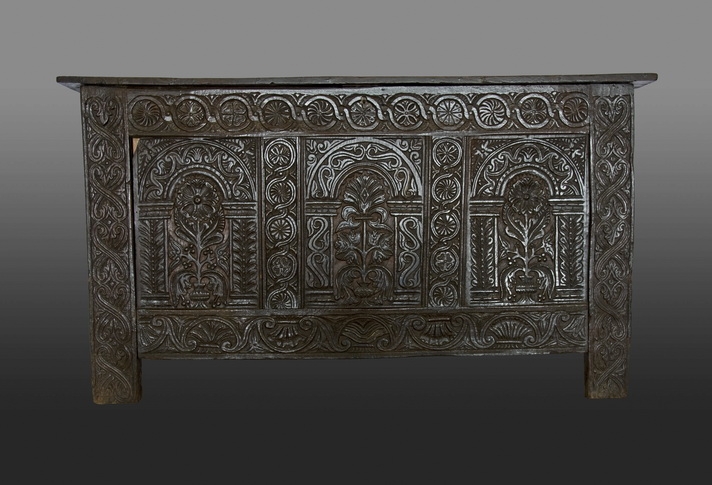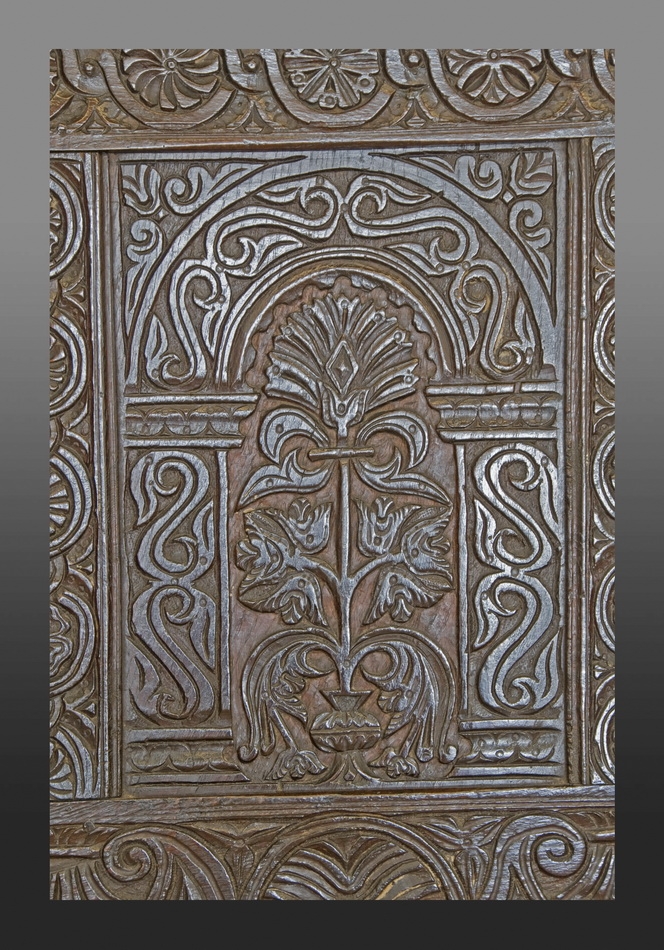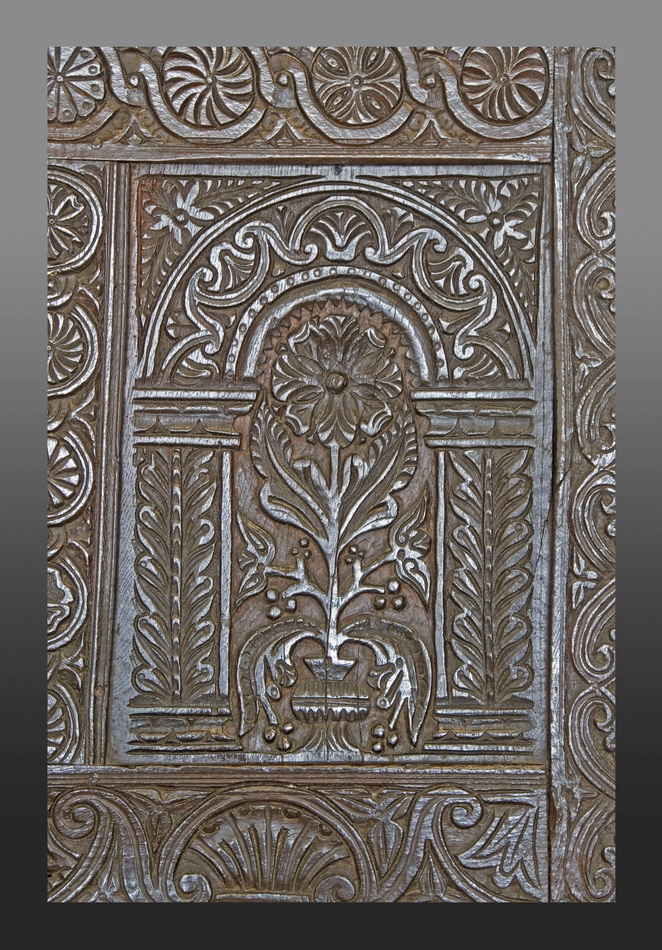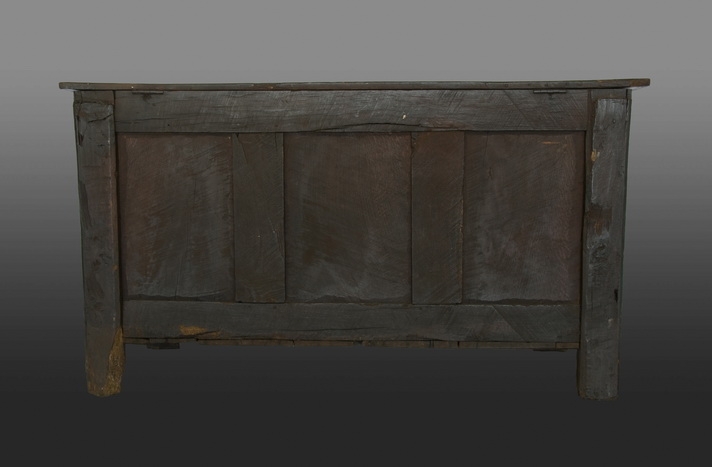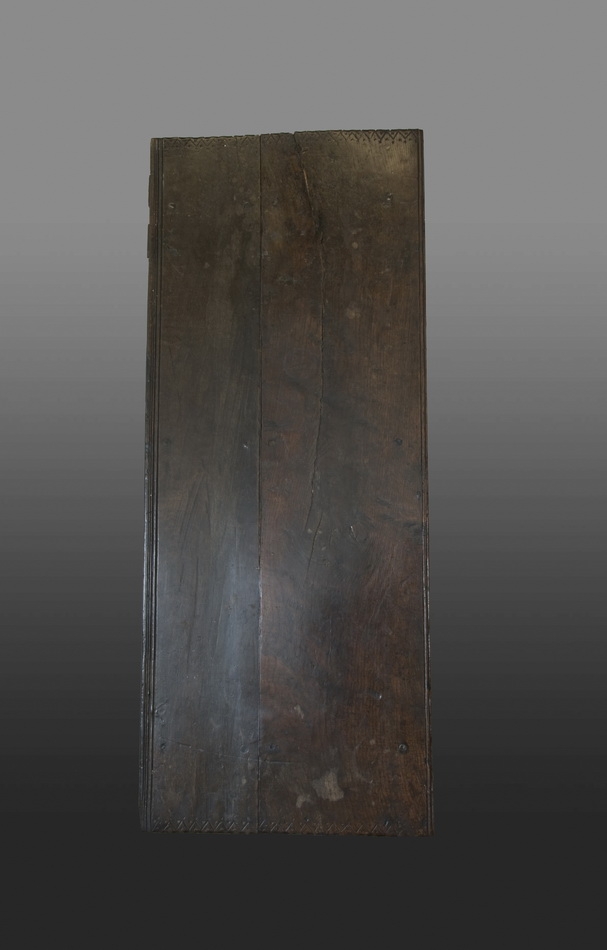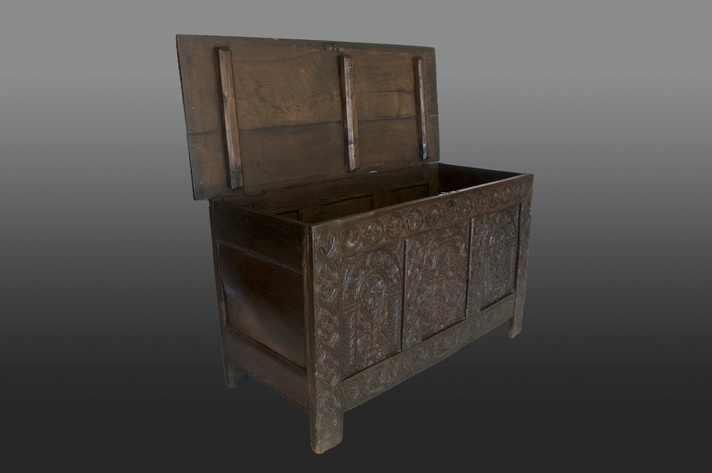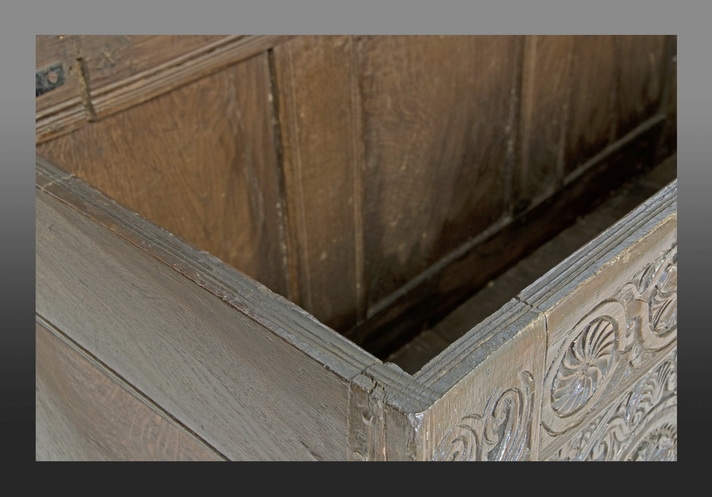Charles II East Devon chest
17th century
Exeter, Devon
W 56.25" × H 31.5" × D 22.75"
Stock # Ex6
SOLD
The antecedent object. This and six other joined chests and a chest-front (cats. 7-8, 13-16, 18) represent the output of four artisans working within a single seventeenth-century Exeter joiners workshop over more than three generations. The chests and chest-front share so many traits which occur together only in the work of the Dennis Shop in New England that the joiners who made them almost undoubtedly worked within the same shop in which Dennis apprenticed. This chest is the earliest of the group; its maker was likely the master of the artisans responsible for the six related objects and, there is substantial reason to believe, of Thomas Dennis. It's earlier date is indicated by the quantity and relative high-quality of the timber as opposed to the scant, poor quality oak employed in later Exeter joined furniture, the vibrancy of the carving, and the presence of alternating shell-like lunettes carved on the front bottom rail. The latter motif appears on high-level Exeter fixed woodwork of the late sixteenth and early seventeenth centuries, including the suite of paneling recovered from a house in Exeter in the mid-nineteenth century (Victoria & Albert Museum) and the Oak Room in the Elizabethan Bympfylde House that once stood in the City centre (Peter Thomas and Jacqueline Warren, Aspects of Exeter (Plymouth: Barron Jay, 1980), pp. 231-236). This shell-like motif that has no known parallels in New England Exeter-derived joinery and the use of elaborate pseudo-architectural arcades to frame the carving in the centre of the front panels reflect the artisans engagement with design sensibilities of the late sixteenth century which were less familiar to joiners of Thomas Dennis generation. The remainder of the carved ornament is pure Dennis. Individual motifs and patterns and the manner in which they are arranged within the larger composition prefigure the carved ornament of three of the most elaborate and thoroughly documented examples of Thomas Dennis work to survive. The front top rail is carved with a sequence of eleven rosettes linked in guilloche, each different from the next. A portion of the same sequence (eight) of subtly varied rosettes in guilloche is repeated on the drawer front of the box with drawer which descended in the Dennis family and was found containing a number of Thomas Dennis personal papers (Bowdoin College Museum of Art). Use of linked double s-scrolls as appear carved on the faces of the front stiles of the chest was a standard Dennis strategy for ornamenting the stiles, rails, and muntins of joined chests. The arrangement of botanical motifs (a vertical stem surmounted by a serrated flowerhead flanked by asymmetric leafage) emerging from a classicised urn that occupies the centres of the front panels is a more intricate and compressed rendition of the pattern carved by Dennis on the back panel of a great chair which descended in his family along with the box with drawer (Bowdoin College Museum of Art) and a joined chest constructed for prosperous Ipswich, Massachusetts residents John and Margaret Staniford and dated 1676 (Winterthur Museum).
The chest also serves to introduce two key traits of later seventeenth-century Exeter and Exeter-derived New England joinery. It provides the earliest evidence of an Exeter joiner applying polychromy to the dropped ground surrounding relief carving, an ornamental approach employed extensively by later seventeenth-century Exeter joiners and the Dennis shop. Most importantly, the chest is the earliest example that features the V-V-ogee moulding which appears on all examples of Dennis shop joined case furniture and also numerous later Exeter pieces. Unlike Dennis shop joined chests on which this distinctive moulding is usually confined to the side rails, the V-V-ogee covers this chest. It appears on the front bottom rail, the side profiles of the stiles, the rear edge of the lid, the top profiles of all framing members (a usage not known in New England), and on the inner surfaces of the rear framing members. With minor variations, the measurements of the elements of the V-V-ogee mouldings worked on Dennis shop joinery are unique. On all other examples Exeter joinery on which the moulding appears, the measurements of the V-V-ogee vary slightly. This reflects the realities of different artisans applying the same concept but with their own unique tools. The V-V-ogee on this chest, however, is a one-to-one match to the profiles employed by Dennis. This fact is even more extraordinary when one considers that the moulding planes used by joiners were by nature ephemeral tools; use and repetitive sharpening altered their profiles over time. This correspondence between two objects separated by several decades and an ocean is not a coincidence and can only be taken as evidence of a direct, perhaps familial, link between the two artisans involved – the maker of this chest and Thomas Dennis.
Condition Notes
Remains of original polychromy. All bottom boards save one replaced; cleats lost.
